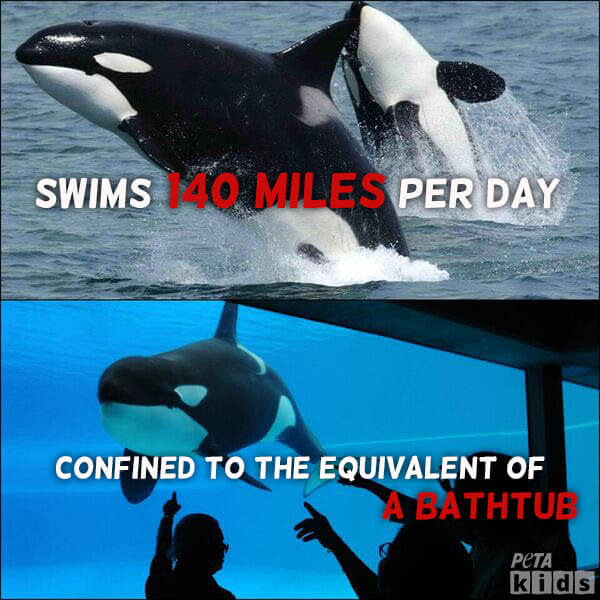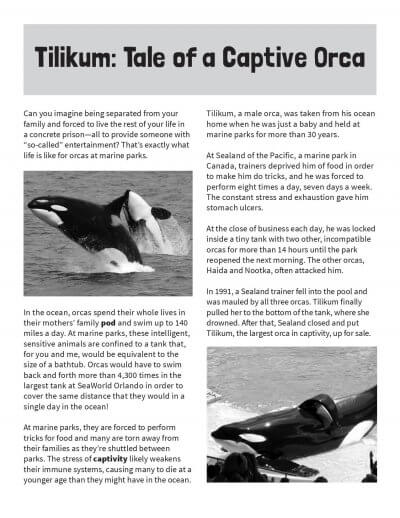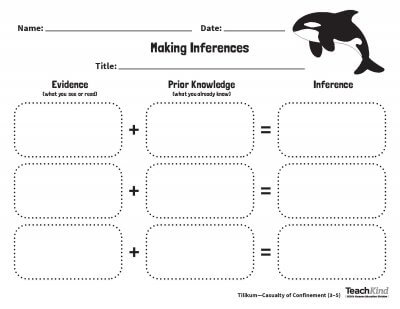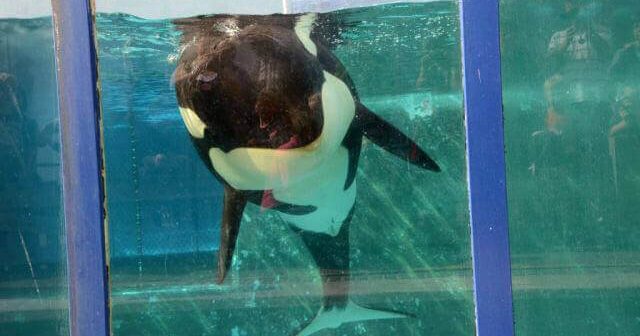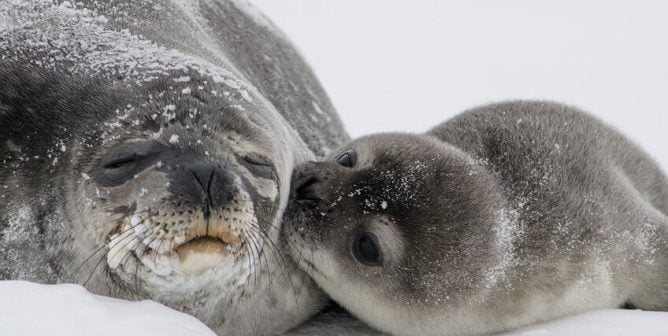Tilikum: Casualty of Confinement (Grades 3–5)
This lesson plan is designed to help teachers present animal rights issues to their students. If you’re an educator, please feel free to adapt this material to fit your needs, and contact us if you need help incorporating this activity into your curriculum.
Suggested grade levels: 3–5
Objectives
Affective: Students will be able to demonstrate an understanding of orcas as individuals and why it’s cruel to keep them in marine parks.
Cognitive: Students will be able to make inferences by linking details in a text to their prior knowledge.
Background
Free-roaming orcas live in large, complex social groups and swim vast distances every day in the open ocean. When imprisoned for entertainment, these animals are confined to tanks that are equivalent to the size of bathtubs for humans, restricting them to swimming in endless circles, and they’re denied the opportunity to engage in almost any natural behavior. They’re forced to perform meaningless tricks, and many are torn away from family members when they’re shuffled between parks or abducted from their ocean homes. While free-roaming male orcas live an average of 30 years and up to 60 and females an average of 50 and up to more than 100, 41 orcas have died on SeaWorld’s watch—at an average age of only 14. Not one has reached the maximum life expectancy of the species in nature.
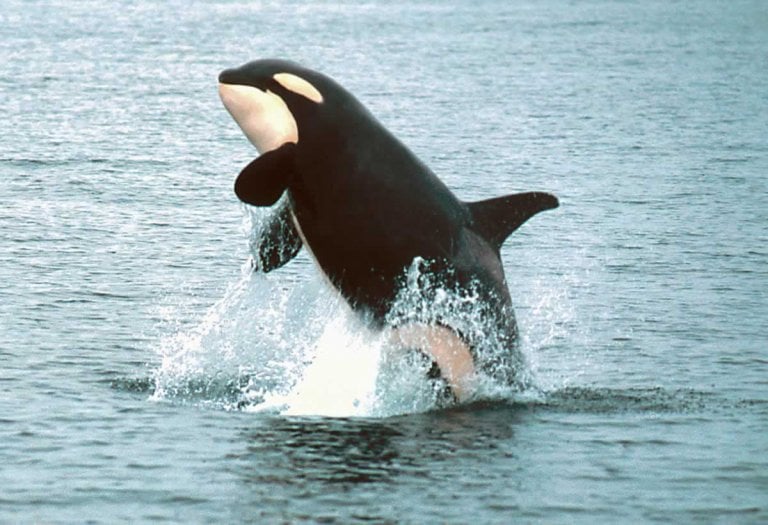
Materials
Resources
- Orcas—Natural Habitat vs. Imprisonment PETA Kids image
- “Which Life Would You Choose?” PETA Kids image
- “Corky’s Sad Story” video
Key Vocabulary
Captivity: the state of being held, imprisoned, enslaved, or confined
Breeding: animals’ mating and production of offspring
Pod: a group of dolphins or whales
Seaside sanctuary: a protected coastal location where cetaceans (porpoises, dolphins, and whales) can be rehabilitated or can live permanently in an ocean environment that maximizes well-being and independence and is as close as possible to their natural habitat
Motivation
The image below shows a photo of orcas in their natural habitat and a photo of an orca imprisoned for entertainment. Write the following critical-thinking instructions and questions on the board and have students discuss them in small groups. Then, have each group share its responses with the whole class.
- Describe what you think is happening in each picture. Use details from the photographs to explain your answers.
- How do you think the orcas feel? What makes you think this?
- How do you feel when you look at each photograph? Why?
- What other conclusions can you draw from looking at the orcas in these photographs? Provide evidence for your thinking.
Explain to the students that many people don’t realize what life is like for orcas used for entertainment because they don’t fully understand an orca’s needs and they don’t see what happens behind the scenes at marine parks. Then, ask the students the following questions:
- Why do you think humans keep orcas in marine parks such as SeaWorld? (They do it to make money—people buy tickets to see the animals.)
- Is it fair to keep orcas captive in marine parks such as SeaWorld? Explain your answer.
Before Reading
Ask students what an inference is and discuss the definition as a class. (An inference is a new idea formed by combining clues from a text or visual aid with what you already know.)
Explain that making inferences helps us understand information that isn’t directly stated. Discuss the necessary steps for inferring, such as looking for important textual and/or visual details (clues) and considering what you already know about the topic (prior knowledge). Use the clues and your prior knowledge to decide what the author of the work is telling you indirectly.
Model the process of inferring by displaying the “Which Life Would You Choose?” PETA Kids advertisement below. Make a chart-size version of the inferencing graphic organizer and discuss inferences that could be made about the visual images in the ad using the organizer. Think aloud: “What do I think PETA Kids wants us to do? What makes me think so?”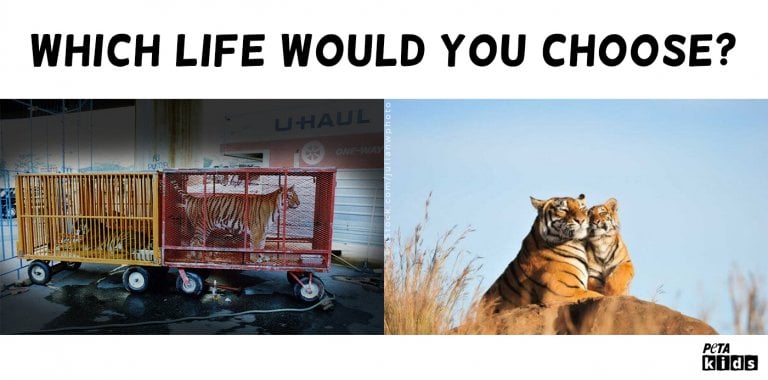 Here’s an example of what one could infer.
Here’s an example of what one could infer.
- Details from the images: I see two tigers in cages on one side and two tigers in the wild on the other side, and the text reads, “Which Life Would You Choose?”
- Prior knowledge: I know that tigers are wildlife (not domesticated animals like dogs and cats) and that their natural habitats are forests, grasslands, and savannas. Tigers are an endangered species, which means that they’re in danger of becoming extinct. Circuses keep tigers in cages and force them to perform tricks. I also know that PETA works to help animals.
- Inference: I think PETA wants to show us that tigers live sad lives inside cages in the circus, because they don’t have their freedom—their lives are very different from those of animals in the wild. I think PETA wants us to help tigers by not going to circuses that use animals.
Model how to include the pertinent information on the chart-size graphic organizer.
Ask students, “How do you think tigers feel when they are kept in cages and are unable to roam freely? What makes you think that?” (Example: They may feel sad, angry, depressed, and frustrated. Just like humans, tigers want to be free.)
During Reading
- Read aloud the first three paragraphs of “Tilikum: Tale of a Captive Orca”.
- Have students work with a partner to complete the Inferencing graphic organizer based on the following question: Why would the author use the phrase “so-called entertainment” to describe orcas in marine parks and aquariums?
- Review possible answers as a class.
- Text details: The text says that orcas perform tricks and are confined to tanks that don’t allow them to swim up to 140 miles per day, as they would in their ocean habitat.
- Prior knowledge: I know that “so-called” is used when referring to something by a name that doesn’t describe it correctly and that entertainment is provided by performers who willingly participate.
- Inference: I infer that since orcas are denied their freedom and aren’t allowed to choose whether or not to participate, they shouldn’t be imprisoned for entertainment.
- Have students read the rest of the text and use the graphic organizer to complete the following questions (independently or with a partner).
- Why do you think orcas experience stress when they’re imprisoned for entertainment? Possible responses:
- Text details: I read that many captive orcas are torn away from their families and confined to a tank that’s equivalent in size to a bathtub for humans.
- Prior knowledge: I know that families are important to both humans and animals and that when I’m confined to a small space, I get frustrated.
- Inference: I infer that it’s stressful for orcas to experience confinement without the freedom to swim up to 140 miles per day—as they would in their ocean habitat—and it’s difficult for them to be separated from their families, since in the wild, orcas live with their families for their whole lives.
- Text details: I read that Tilikum was the largest orca in captivity and that SeaWorld bought him for its breeding program.
- Prior knowledge: I know that people like to have and see the biggest of anything and that SeaWorld wanted Tilikum to have offspring.
- Inference: I infer that SeaWorld wanted to sell more tickets by telling the public to come to its parks to see “the largest orca in captivity” and that it thought that Tilikum’s offspring might be large, too.
- Then, ask them to make another inference on their own and cite textual evidence and prior knowledge to support it.
- As a final step, ask students to use the information from their completed graphic organizer to write a paragraph about the subject.
After Reading
Turn and Talk: Explain that orca aggression toward humans and other orcas is nearly non-existent in nature. But there are many documented incidents in which captive orcas have injured or even killed SeaWorld trainers. Ask students, “Why do you think orcas used for entertainment lash out and hurt humans?” Discuss the responses as a class. (Possible response: They experience stress from confinement and frustration from being separated from their family pod. So they probably lash out because they’re angry about being held for entertainment against their will.)
Real World Connection
Tell students that it’s too late for Tilikum, but we can help the other animals who are still trapped at SeaWorld and other marine parks. Explain that every dollar spent on tickets to marine parks and other places that hold animals captive contributes to animals’ misery.
Then, share the story of Corky, the oldest orca in captivity. Show students the video “Corky’s Sad Story.”
Ask students to imagine that they’re an orca like Corky. Have them fold poster paper in half. Then, have them draw a picture of what they imagine that their life would be like in an ocean habitat (on one side) vs. in a marine park (on the other side). Have them write a caption beneath each picture.
Ask students, “Do you think it’s OK to go to SeaWorld or other marine parks? Why or why not?” Discuss the responses as a class.
Wrap-Up
Have students share posters and discuss what they can do to help orcas like Corky (e.g., not visit marine parks, roadside zoos, or aquariums that use ocean animals for entertainment). Tell students that SeaWorld stopped breeding orcas (so the current generation of orcas held captive at its parks will be the last) only after it was put under pressure from people who care about animals—showing that when people speak up, they can make a difference.
Assessment
Evaluate student writing for inferences that include textual evidence and use of prior knowledge. Evaluate posters for concepts of life in the wild vs. life in a marine park.
Common Misperception
Marine parks and aquariums provide visitors with educational opportunities.
Reality
Aquariums and marine-mammal theme parks such as SeaWorld, the Miami Seaquarium, and Canada’s Marineland are part of a billion-dollar industry that teaches people that it’s acceptable to imprison animals, deprive them of freedom of movement, forbid them the chance to establish natural territory and explore, breed and group them as we—not they—please, and watch them go insane from frustration and loneliness. The only thing that people learn from visiting a marine park is how miserable life is for the animals confined there. Children who visit these parks see mere shadows of animals, defeated beings who can’t engage in natural types of behavior or live as nature intended.
Extension
- Identify an area in your classroom that’s the size of a bathtub and have students see how long they can stay in that area before they get frustrated and bored. Discuss what life must be like for orcas who aren’t free to leave their area as the students could.
- Send letters to your local aquarium to ask that it create more space for rehabilitating (and releasing) injured wildlife by refusing to breed or bring in any more animals.
- Show students the video “Kids Stand Up to SeaWorld,” and make a class pledge never to support SeaWorld. You can make a class pledge poster that the whole class signs or have students write individual pledges that include their reasons for making the decision not to support these marine parks. Hang the pledges in the hallway outside your classroom.
Common Core Standards Addressed
- RI.3.1: Ask and answer questions to demonstrate understanding of a text, referring explicitly to the text as the basis for the answers.
- RI.4.1: Refer to details and examples in a text when explaining what the text says explicitly and when drawing inferences from the text.
- RI.5.1: Quote accurately from a text when explaining what the text says explicitly and when drawing inferences from the text.
- SL.3–5.1: Engage effectively in a range of collaborative discussions (one-on-one, in groups, and teacher-led) with diverse partners on grade-level topics and texts, building on others’ ideas and expressing their own clearly.
Additional Information
SeaWorldOfHurt.com (for teachers)
PETAKids.com (for students)
Common Core Standards. © 2010. National Governors Association Center for Best Practices and Council of Chief State School Officers. All rights reserved.

